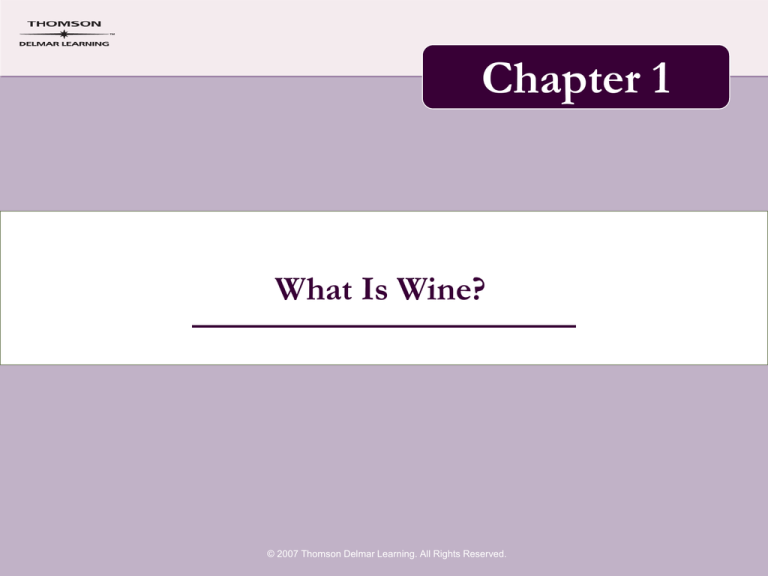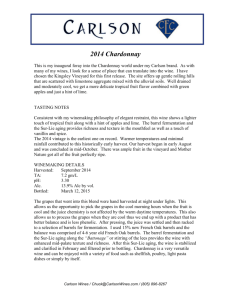
Chapter 1
What Is Wine?
© 2007 Thomson Delmar Learning. All Rights Reserved.
Objectives
• After reading this chapter, you should be able to
– discuss the historical origins of winemaking.
– describe the influence of the Greek and Roman
civilizations on winemaking.
– explain the role of the church in winemaking during
the Middle Ages.
– describe the economic cycles of grape growing and
winemaking.
© 2007 Thomson Delmar Learning. All Rights Reserved.
Introduction
• Wine has been an integral part of the human
experience for nearly 70 centuries.
• Wine is the result of the fermentation of juice from
grapes.
• Fermentation is a natural process that acts to
stabilize grape juice and allow it to be stored as wine
for later consumption.
• The alcohol in wine that is produced by
fermentation also prevents the growth of
pathogenic microorganisms.
© 2007 Thomson Delmar Learning. All Rights Reserved.
Introduction (continued)
• Over the centuries different cultures have had
contrasting opinions on wine.
– Some regard it as an essential and healthful
beverage, others have shunned its use and
consider it sinful.
– These competing ideas have influenced the
development of wine during the course of
history, and continue to affect its place in society
today.
© 2007 Thomson Delmar Learning. All Rights Reserved.
The History of Wine
• Wine was first consumed in the areas of Persia
(modern day Iran) around 5000 to 6000 BC.
– Though the exact nature of the wine is uncertain, it was
probably made from dates or other tree fruits native to
the region rather than grapes.
• Around 3000 BC, winemaking from grapes began
with the Egyptians and the Phoenicians producing
wines from grapes.
© 2007 Thomson Delmar Learning. All Rights Reserved.
The History of Wine (continued)
• Ancient Egyptian artwork and sculptures
provide a great deal of information about the
winemaking practices of the time.
– The paintings indicate that wine production had
evolved into an elaborate procedure.
• Containers of wine have been found in royal
burial chambers for the dead to enjoy in the
afterlife.
– The vessels were marked with the origin and
vintage of the grapes that produced the wine.
© 2007 Thomson Delmar Learning. All Rights Reserved.
Ancient Greece
• By 2000 BC, wine had become an important
part of Greek culture.
• Beginning around 1000 BC, the expansion of
the Greek empire brought vineyards and
winemaking to regions throughout the
Mediterranean basin.
– Including parts of North Africa, Southern Spain,
southwest France, Sicily, and much of the Italian
mainland.
© 2007 Thomson Delmar Learning. All Rights Reserved.
Ancient Greece (continued)
• The wine was most likely made from dried
grapes or raisins.
– The Greeks stored their wines in containers
called amphorae.
• Like the Egyptians before them, wine
occupied a large place in Greek society and
The Greeks created a deity, Dionysus, in
honor of wine.
© 2007 Thomson Delmar Learning. All Rights Reserved.
The Roman Era
• Though the growing of wine grapes in Italy
predated the rise of the Roman Empire by many
centuries, the Romans took viticulture and
winemaking to a new height.
– They began the practice of trellising vines off the
ground by training them to grow up trees.
– The Romans' technological advances in winemaking were
thoroughly documented in literature and art.
• The Romans were first-rate barrel makers or
coopers, and storage in wooden barrels as well as in
clay amphorae was common.
© 2007 Thomson Delmar Learning. All Rights Reserved.
The Roman Era (continued)
• As it had with the Greeks, Roman viticulture and
winemaking followed Roman legions as they pushed
the boundaries of their empire north and westward.
– The Romans grew grapes throughout Italy, expanded the
vineyards of Spain north to the Pyrenees, throughout
what is now modern Portugal and France, and around the
first century they continued the expansion into what is
now modern Germany.
© 2007 Thomson Delmar Learning. All Rights Reserved.
The Roman Era (continued)
• The Romans were keen observers of the agricultural
process.
– Books, dating from as early as the third century BC,
describe grape growing and winemaking in detail.
– Their knowledge of matching grape varieties to soils and
climates, trellising, and other growing techniques form
the basis for many contemporary practices.
– The medicinal qualities of wine were also highly regarded
by the Romans.
© 2007 Thomson Delmar Learning. All Rights Reserved.
The Roman Era (continued)
• Wine was also significant to Jewish and early
Christian cultures.
• Wine is mentioned more than 150 times in the Old
Testament and is an important part of Jewish
religious celebrations such as weddings and
Passover.
• As Christianity grew in popularity, the religious
significance of wine also grew.
– Christ’s first miracle was the conversion of water to wine.
– Christians also consumed wine as a sacrament during
Mass in a reenactment of the Last Supper.
© 2007 Thomson Delmar Learning. All Rights Reserved.
The Middle Ages
• The fall of Rome, at the end of the second century, ushered
in a long period of great strife throughout the civilized
world.
• Wars between the Franks, Teutons, and Goths brought
widespread destruction.
• In the seventh century AD, the Moors of North Africa
crossed the Straits of Gibraltar and invaded Spain.
– Although the Moors’ Islamic faith prevented them from consuming
alcohol, they allowed viticulture and winemaking to continue in the
region.
© 2007 Thomson Delmar Learning. All Rights Reserved.
The Middle Ages (continued)
• During the Middle Ages, the practice of agricultural activity
in much of Europe fell to the Catholic Church.
– Some of the monasteries became great centers of study and
commerce.
• In the early seventh century, Pope Gregory the Great
instructed the monastic orders to expand wine production,
and the planting of wine grapes again began to spread.
– The church kept strict control of winemaking. Grapes were required
to be pressed in monasteries, for which a “donation” of ten percent
of production was taken.
© 2007 Thomson Delmar Learning. All Rights Reserved.
The Middle Ages (continued)
• Monks continued the study of viticulture (grape growing)
and winemaking (enology) begun by their Roman
predecessors.
– Matching grape varieties to soil conditions and climate, propagation
and planting, trellising, crushing, fermenting, fining, and storage were
all meticulously studied and improved.
• Villages formed around monasteries, many growing into
cities of 20,000 or more.
• Farmers began using the skills learned from the monks to
improve and expand their own vineyards.
© 2007 Thomson Delmar Learning. All Rights Reserved.
Twelfth Century to Modern Times
• By the twelfth century, the political landscape of Europe had
undergone great changes.
• The Norman Conquest in 1066 had created a situation where
English kings were also French nobility with the right to own
lands on both sides of the English Channel.
• During the reigns of Henry II and his son, Richard the Lion
Hearted, the English developed an enormous thirst for the
wines of France. Wines from Languedoc, Loire, and
Bordeaux poured across the channel.
© 2007 Thomson Delmar Learning. All Rights Reserved.
Twelfth Century to Modern Times
(continued)
• It took nearly three centuries, including a continuing
series of wars for the French to dislodge the English
from their precious vineyards.
– In 1429, led by Joan of Arc, the French drove the English
out of the Loire Valley, and in 1453, they succeeded in
expelling them from Bordeaux.
– With the loss of their French territories, the British
turned to other regions such as Germany, Italy, Portugal,
and Spain to satisfy their thirst for wine.
© 2007 Thomson Delmar Learning. All Rights Reserved.
Twelfth Century to Modern Times
(continued)
• By the end of the fifteenth century, the great European
Renaissance was well underway.
– Literally a “rebirth” in creative thinking, the Renaissance was to have
a profound effect on religion, philosophy, science, and art.
• The monastic orders became easy targets for religious
reformers, and it wasn’t long before their economic and
political hold on the populace began to fade.
• By the end of the seventeenth century, much of the church’s
vineyard holdings had been broken up and passed back into
private hands.
© 2007 Thomson Delmar Learning. All Rights Reserved.
The Introduction of Champagne
• The early eighteenth century saw the widespread use of cork
as a bottle stopper and the development of sparkling wine or
Champagne.
– This is more than a coincidence because Champagne bottles require
a good seal.
• Although the Benedictine monk, Dom Perignon, is often
credited with the discovery of Champagne, he probably
produced them by accident and others developed the
techniques of production.
• Cork revolutionized the storing and aging of wines, making
it possible to age them for long periods and to ship them in
bottles to distant markets.
© 2007 Thomson Delmar Learning. All Rights Reserved.
Golden Age of Wine
• It was in the ninetieth century, though, that wine
enjoyed its greatest advances and suffered one of its
most devastating blows.
• The advent of modern studies of chemistry and
microbiology brought a deeper understanding of
the winemaking process, and the laboratory soon
began playing a major role in winemaking.
– This better understanding of technology, combined with
the knowledge gained by centuries of trial and error in
European vineyards, resulted in huge advances in the
quality of wine.
© 2007 Thomson Delmar Learning. All Rights Reserved.
Golden Age of Wine (continued)
• As the science and caliber of wine took a leap
forward, wine appreciation in the modern sense was
born.
• Attracted to the glamour of winemaking, the
wealthy soon began buying up vineyards throughout
Europe labeling their products with both their
family and estate names.
• The French established a system to classify their
vineyards.
© 2007 Thomson Delmar Learning. All Rights Reserved.
Phylloxera
• In the second half of the ninetieth century, disaster
struck in the form of a microscopic root louse,
phylloxera, that is native to the eastern United
States.
– The pest was brought to France on a ship carrying
grapevines that were native to North America.
– By 1868, phylloxera had been identified in southern
France. Within 20 years, it spread throughout the country,
destroying most of the vineyards.
– By 1874, it had also infected Germany, and soon all the
vineyards of Europe were infected.
© 2007 Thomson Delmar Learning. All Rights Reserved.
Phylloxera (continued)
• It was not until growers began replanting
their vineyards with rootstocks from North
America that were resistant to the pest that
Europe’s winemaking industry was revived.
• This practice is still used today where
phylloxera is present.
© 2007 Thomson Delmar Learning. All Rights Reserved.
The New World
• It was during the late nineteenth and early twentieth
centuries that the wine industry in the New World
became commercially important.
– Though some areas, especially California, had an already
established wine industry, many of today’s new-world
wine regions trace their start to the years between 1880
and 1910.
• Vineyards in North and South America, Australia,
and South Africa flourished with the influx of
immigrants from Europe.
© 2007 Thomson Delmar Learning. All Rights Reserved.
The New World (continued)
• The new-world producers took their cue from their
European predecessors, in many cases borrowing
grape varieties, techniques, and technologies.
• However, when winemakers from different growing
regions of Europe came to the New World, they
adapted old-world methods to the particular
conditions in their new homes.
– This combination of winemaking techniques from
around Europe helped to create many innovations.
© 2007 Thomson Delmar Learning. All Rights Reserved.
The Twentieth Century
• The first half of the twentieth century, with its two
devastating world wars, again saw setbacks in
winemaking worldwide.
• In America, this was compounded by Prohibition,
which outlawed the sale or consumption of
alcoholic beverages from 1919 until 1933.
– The temperance movement had been gaining ground for
100 years, and at the end of World War I, the Volsted
Act was passed implementing prohibition as the 18th
Amendment.
© 2007 Thomson Delmar Learning. All Rights Reserved.
The Twentieth Century (continued)
• Prohibition did little to control alcohol consumption, and
Americans continued to drink “bootleg” alcohol obtained
illegally or primitive wines made at home.
• The 18th amendment was repealed in 1933 when it became
obvious that it was not working.
– During prohibition Americans’ tastes changed because wine drinkers
became used to drinking substandard homemade wines.
– As part of repeal, each state was allowed to make its own regulations
governing alcohol that led to a confusing patchwork of state laws
that still survive.
© 2007 Thomson Delmar Learning. All Rights Reserved.
The Twentieth Century (continued)
• Following the Second World War, both the
old- and new-world wine industries saw a
resurgence as reconstruction monies flowed
to Europe and returning U.S. servicemen
came home with a newly acquired interest in
wine.
• By the 1950s, wine, as a beverage and as a
business, was again on the rise.
© 2007 Thomson Delmar Learning. All Rights Reserved.
The Twentieth Century (continued)
• Throughout the 1960s and 1970s, wine
production and consumption grew at an
increasing pace.
– In America producers began naming their wines
after the grape varieties they were made of (e.g.,
Cabernet Sauvignon or Chardonnay) instead of
following the common practice of using French
geographic names, such as Burgundy or Chablis,
to identify their wines.
© 2007 Thomson Delmar Learning. All Rights Reserved.
Wine Today
• Since the early 1970s, the wine world has
been undergoing another huge
transformation in both the Old and New
Worlds.
• Where before there were only a handful of
producers making high-quality wines, today
there are thousands of producers throughout
the world making excellent wines.
© 2007 Thomson Delmar Learning. All Rights Reserved.
Wine Today (continued)
• Behind this explosion of quality producers
lies a greater consumer interest in fine wines
and the broader availability of state-of-the-art
technology and winemaking expertise.
– New technology in both the vineyard and winery
is widespread throughout the world.
© 2007 Thomson Delmar Learning. All Rights Reserved.
Globalization
• In Europe, the lesser known regions of southern France,
Italy, Spain, Greece, Hungary, and even the former countries
of the Eastern Block are now making wines that are on par
with those of some of the best traditional growing regions.
• In the United States, New York, Washington, Oregon,
Virginia, and Texas are now recognized wine producers.
• Australia, New Zealand, Chile, Argentina, Hungary, and
South Africa have also become known for producing wines
of excellent value.
© 2007 Thomson Delmar Learning. All Rights Reserved.
Globalization (continued)
• The worldwide focus on quality improvement has
led to the increasing standardization of taste and
styles.
– There has also been a movement toward making softer,
less tannic wines that require little bottle aging before
they are consumed.
• This global viewpoint and increased competition
has resulted in consolidation of many winemaking
companies.
– While this globalization of the industry has led to better
prices and more consistently good products, some feel it
has also made wines from around the world more
homogenous and uninteresting.
© 2007 Thomson Delmar Learning. All Rights Reserved.
Economic Cycles in the Wine
Business
• Wine, because it is made from grapes, is considered
an agricultural product, and like many other
agricultural products, it exhibits a boom and bust
economic pattern.
• Because of the time it takes to establish a new
vineyard, get a crop from its vines, and then
produce a wine from its grapes, it is very difficult for
growers and vintners to respond to changing market
conditions.
© 2007 Thomson Delmar Learning. All Rights Reserved.
Economic Cycles in the Wine
Business (continued)
• Boom and bust economic pattern
– The popularity of a certain variety of wine will lead to
scarcity of the grapes used to produce it, resulting in high
prices.
– At this point, many growers will plant the variety to take
advantage of the higher prices resulting in
overproduction and ultimately lower prices for their crop.
– Another factor influencing the economics of winemaking
is the fact that many wine consumers consider wine a
“luxury item” and not a food.
© 2007 Thomson Delmar Learning. All Rights Reserved.
Summary
• In the Old World there is now a movement to blend
new technology with traditional grapes and winemaking
techniques.
• New World countries like Chile and Australia have
invested heavily in new vineyards and wineries to take
advantage of the export market.
• While total wine consumption worldwide is falling,
demand for premium wines in Europe, North America,
and the Far East continues to grow. This has been
matched by increased plantings throughout the world to
meet the anticipated need.
© 2007 Thomson Delmar Learning. All Rights Reserved.
Summary (continued)
• In the United States demand for California wines
has been tempered by inexpensive imports from
South America and Australia.
• The wine business climate today is similar to one
that existed during the early 1980s when excess
production of grapes and wine led to reasonably
priced, high-quality wines that brought in many new
consumers.
• These new wine drinkers in turn helped to fuel new
growth.
© 2007 Thomson Delmar Learning. All Rights Reserved.






